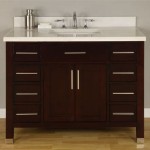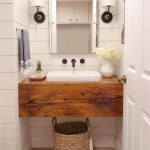60 Inch Natural Wood Vanity: A Comprehensive Guide
The 60 inch natural wood vanity represents a popular choice for homeowners seeking to renovate or upgrade their bathrooms. This size provides ample storage and counter space, suitable for master bathrooms, shared bathrooms, or larger powder rooms. The "natural wood" element introduces warmth and a sense of organic beauty, offering versatility that complements a wide range of design aesthetics. This article will explore the various aspects of 60 inch natural wood vanities, covering materials, styles, installation considerations, and maintenance tips.
The size of a 60 inch vanity offers a significant advantage over smaller options. It allows for more substantial storage, often incorporating drawers, cabinets, and open shelving. This enhanced storage capacity reduces clutter and contributes to a more organized and functional bathroom. Furthermore, the increased counter space provides room for toiletries, decorative items, and even dual sinks in some installations. The selection of a 60 inch vanity is often dictated by the bathroom's dimensions, as it requires sufficient wall space and floor area to avoid overwhelming the room.
Material Considerations for Natural Wood Vanities
The term "natural wood" encompasses a diverse range of wood species, each possessing unique characteristics in terms of grain, color, hardness, and durability. Understanding these differences is crucial for selecting a vanity that aligns with both aesthetic preferences and functional requirements.
Oak: Oak is a classic choice, known for its strength and distinctive grain pattern. It is a durable option that can withstand the humidity often present in bathrooms. Oak can be stained in a variety of shades, from light and airy to dark and rich, allowing for customization to match various color palettes.
Maple: Maple is a hardwood characterized by its smooth, fine grain and light color. It accepts stains well and offers a clean, contemporary look. Maple is generally less porous than oak, making it a good choice for resisting moisture damage.
Cherry: Cherry wood is prized for its reddish-brown hue and elegant grain. It is a durable hardwood that develops a richer color over time. Cherry wood vanities offer a sophisticated and timeless appeal.
Walnut: Walnut is a dark, luxurious hardwood known for its rich color and striking grain patterns. It is a durable and stable wood that offers a distinctive and upscale aesthetic. Walnut vanities often command a higher price point due to the wood's rarity and desirability.
Birch: Birch is a lighter, more affordable hardwood option. It is known for its smooth texture and uniform grain. Birch is often used as a base for painted finishes, but it can also be stained to showcase its natural beauty.
Reclaimed Wood: Reclaimed wood vanities offer a unique and eco-friendly option. Reclaimed wood can come from various sources, such as old barns, factories, or warehouses. Each piece of reclaimed wood has its own story and character, adding a touch of rustic charm to the bathroom. The wood is typically treated and sealed to ensure its suitability for a bathroom environment.
Beyond the wood species, construction methods also influence the vanity's quality and longevity. Solid wood construction, where the entire vanity is made from solid wood planks, is generally considered the most durable option. However, solid wood can be susceptible to expansion and contraction with changes in humidity. Plywood construction, using multiple layers of wood veneer glued together, offers greater stability and resistance to warping. Many high-quality vanities combine solid wood elements with plywood panels to achieve a balance of durability and stability.
The finish applied to the natural wood vanity plays a crucial role in protecting the wood from moisture and enhancing its aesthetic appeal. Common finish options include varnish, lacquer, polyurethane, and oil-based finishes. Each finish offers different levels of protection, durability, and sheen. A water-resistant finish is essential for preventing water damage and ensuring the vanity's longevity.
Styles and Design Considerations
60 inch natural wood vanities are available in a wide variety of styles to suit diverse design preferences. The style of the vanity should complement the overall aesthetic of the bathroom and reflect the homeowner's personal taste.
Traditional: Traditional vanities often feature ornate details, such as raised panel doors, carved moldings, and decorative hardware. These vanities evoke a sense of classic elegance and sophistication. They typically incorporate darker wood finishes, such as cherry or walnut.
Modern: Modern vanities are characterized by clean lines, minimalist designs, and a focus on functionality. They often feature slab-front doors, integrated sinks, and sleek hardware. Lighter wood finishes, such as maple or birch, are commonly used in modern vanities.
Transitional: Transitional vanities bridge the gap between traditional and modern styles. They combine classic elements with contemporary details, creating a balanced and versatile look. Transitional vanities often incorporate shaker-style doors, simple hardware, and a mix of wood finishes.
Rustic: Rustic vanities embrace natural textures and imperfections, creating a warm and inviting ambiance. They often feature reclaimed wood, exposed wood grain, and distressed finishes. Rustic vanities are well-suited for farmhouse-style or cabin-inspired bathrooms.
Contemporary: Contemporary vanities push the boundaries of design, incorporating innovative materials, unique shapes, and unexpected details. They may feature floating designs, asymmetrical layouts, and bold color accents. Contemporary vanities are ideal for those seeking a cutting-edge and fashion-forward look.
Beyond the overall style, several other design considerations can influence the selection of a 60 inch natural wood vanity. The type of countertop, sink, and hardware can significantly impact the vanity's appearance and functionality. Common countertop materials include granite, quartz, marble, and solid surface. Each material offers different levels of durability, stain resistance, and aesthetic appeal. The choice of sink, whether it be undermount, vessel, or integrated, can also contribute to the vanity's overall style.
The hardware selected for the vanity can serve as the "jewelry" that completes the look. Knobs, pulls, and handles are available in a wide range of styles, finishes, and materials. The hardware should complement the vanity's overall design and provide a comfortable and functional grip.
Installation and Maintenance
Proper installation of a 60 inch natural wood vanity is crucial for its stability, functionality, and longevity. While some homeowners may choose to tackle the installation themselves, it is generally recommended to hire a professional plumber or contractor to ensure the job is done correctly.
The installation process typically involves removing the old vanity, preparing the plumbing connections, leveling the new vanity, and securing it to the wall. It is important to ensure that the vanity is properly sealed to prevent water damage and mold growth. The plumber will connect the water supply lines and drainpipes, ensuring that all connections are leak-free.
Once the vanity is installed, regular maintenance is essential for preserving its beauty and extending its lifespan. The vanity should be cleaned regularly with a mild soap and water solution. Avoid using harsh chemicals or abrasive cleaners, as these can damage the finish. Water spills should be wiped up immediately to prevent staining and water damage.
Depending on the wood finish, periodic maintenance may be required to maintain its luster and protect the wood. Wood polishes or oils can be applied to nourish the wood and enhance its natural beauty. It is important to follow the manufacturer's instructions for applying these products. For vanities with stone countertops, a sealant should be applied periodically to prevent staining and water damage.
Regularly inspect the vanity for any signs of water damage, such as discoloration, warping, or mold growth. Addressing these issues promptly can prevent further damage and costly repairs. Check the plumbing connections periodically for leaks and tighten any loose fittings. By following these maintenance tips, homeowners can ensure that their 60 inch natural wood vanity remains a beautiful and functional centerpiece of their bathroom for years to come.

Allen Roth Harwood 60 In Natural Undermount Double Sink Bathroom Vanity With White And Gray Quartz Top At Com

Hargrove Double Bathroom Vanity 60 72 West Elm

Chester 60 Inch Double Sink Natural Wood Vanity

60 Modern Wood Vanity Single Sink What We Make

Vanity Art 60 In W X 22 D 34 H Single Sink Bathroom Natural Oak With Engineered Marble Top Arabescato White Va9060 Sno Gb The Home

60 Quen Double Vanity With Rectangular Undermount Sinks Driftwood Brown Signature Hardware

Roswell Javier 60 In W X 22 D 33 9 H Single Sink Bath Vanity Antique Brown With White Grain Composite Stone Top 806860 Ar Gw Nm The Home

Kesia 60 Single Bathroom Vanity Set In Brown Pine With Aosta White Composite Stone Countertop Without Mirror Wal Com

Hargrove Double Bathroom Vanity 60 72 West Elm

60 Inch Single Bathroom Vanity In Natural Wood







